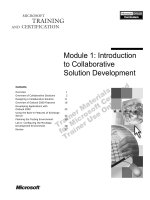Discovering Computers - Chapter 1: Introduction to Computers
Bạn đang xem bản rút gọn của tài liệu. Xem và tải ngay bản đầy đủ của tài liệu tại đây (91.37 MB, 49 trang )
Chapter 1
Introduction to
Computers
Chapter 1 Objectives
Recognize the importance of
computer literacy
Distinguish between system software
and application software
Define the term, computer
Describe the categories of computers
Identify the components
of a computer
Discuss the advantages and
disadvantages of using computers
Identify the elements of
an information system
Describe the various types
of computer users
Recognize the purpose of a network
Discuss the uses of the Internet and
World Wide Web
Discuss various computer
applications in society
Next
A World of Computers
What is computer literacy?
Knowledge and understanding
of computers and their uses
Computers are everywhere
p. 5-6 Fig. 1-1
Next
What Is a Computer?
How is a computer defined?
Electronic device operating under the control of
instructions stored in its own memory
Accepts data
Raw facts, figures, and
symbols
Processes data into
information
Data that is organized,
meaningful, and useful
Produces and stores results
p. 6
Next
What Is a Computer?
What is the information processing cycle?
p. 6 Fig. 1-2
Input
Process
Output
Storage
Communication
Next
The Components of a Computer
What is an input device?
Hardware used
to enter data
and instructions
Click to view Web Link,
click Chapter 1, Click Web Link
from left navigation,
then click Input Devices
below Chapter 1
p. 7 Fig. 1-3
Next
The Components of a Computer
What is an output device?
Hardware that
conveys
information
to one or more
people
Click to view Web Link,
click Chapter 1, Click Web Link
from left navigation,
then click Output Devices
below Chapter 1
p. 8 Fig. 1-3
Next
The Components of a Computer
What is the system unit?
p. 8 Fig. 1-3
Case
containing
electronic
components
used to process
data
Next
The Components of a Computer
What are two main components on the motherboard?
Central Processing Unit (CPU)
Also called a processor
The electronic component that interprets and carries
out the basic instructions that operate the computer
Memory
Consists of electronic components that store
instructions waiting to be executed and data needed by
those instructions
p. 8
Next
The Components of a Computer
What is storage?
Holds data, instructions, and information
for future use
Storage media
Physical material on which data, instructions,
and information are stored
Storage device
Records and retrieves items to and from
a storage medium
p. 8
Next
The Components of a Computer
What is storage media?
Digital
cameras
Portable, thin
memory cards
used in:
p. 8
Handheld
computers
Next
The Components of a Computer
What is a floppy disk?
p. 8
Thin, circular,
flexible disk
enclosed in rigid
plastic shell
Next
The Components of a Computer
What is a USB flash drive?
p. 8
Provides much
greater storage
capacity than a
floppy disk or
Zip® disk
Small and
lightweight enough
to be transported
on a keychain or
in a pocket
Next
The Components of a Computer
What is a hard disk?
Provides greater storage
capacity than a
floppy disk, Zip disk, or
USB flash drive
Most are housed inside
of the system unit
p. 8 Fig. 1-4
Next
The Components of a Computer
What is a compact disc?
Flat, round, portable metal disc
p. 9 Fig. 1-5
CD-ROM
DVD-ROM
Next
The Components of a Computer
What is a communications device?
Hardware component that
enables a computer to
send and receive data, instructions,
and information
Occurs over cables, telephone
lines, cellular radio networks,
satellites, and other
transmission media
Click to view Web Link,
click Chapter 1, Click Web Link
from left navigation,
then click Communications
Devices below Chapter 1
p. 9
Next
Advantages and Disadvantages
of Using Computers
What are the advantages of using computers?
Speed
Reliability
Storage
p. 10
Consistency
Communications
Next
Advantages and Disadvantages
of Using Computers
What are the disadvantages of using computers?
p. 10
Violation of
Privacy
Impact on
Labor Force
Health Risks
Impact on
Environment
Next
Networks and the Internet
What is a network?
Collection of computers and devices connected together
Communications
Device
Enables a
connection
between
computers
Transmission
Media
Satellites
Cables
Telephone
lines
Cellular
radio
One type is
a modem
p. 11
Next
Networks and the Internet
What are the reasons to network?
To share
Resources
Hardware
devices
p. 11
Software
programs
To save
Data
time
Information
and
money
Next
Networks and the Internet
What is a server?
A server manages
the resources on a
network
Clients access
the resources
on the server
p. 11 Fig. 1-6
Next
Networks and the Internet
What is the Internet?
Worldwide collection of networks that connects
millions of businesses, government agencies,
educational institutions, and individuals
Click to view Web Link,
click Chapter 1, Click Web Link
from left navigation,
then click Internet
below Chapter 1
p. 12 Fig. 1-7
Next
Networks and the Internet
Why do users access the Internet?
1. Communications
2. Information
3. Shopping
4. Banking and Investing
5. Classes
6. Entertainment
p. 12-13 Fig. 1-8
Next
Networks and the Internet
What is the Web?
Billions of documents, called Web pages, available to
anyone connected to the Internet
A Web site is
a collection of
related Web pages
p. 12
A Web page contains
text, graphics, sound,
video, and links to
other Web pages
You can share
information by
creating Web pages
or posting photos on
a photo sharing
community
Next
Computer Software
What is software?
Consists of a series
of instructions that
tells the computer
what to do
Also called a
program
Click to view Web Link,
click Chapter 1, Click Web Link
from left navigation,
then click Computer Programs
below Chapter 1
p. 15
Next









